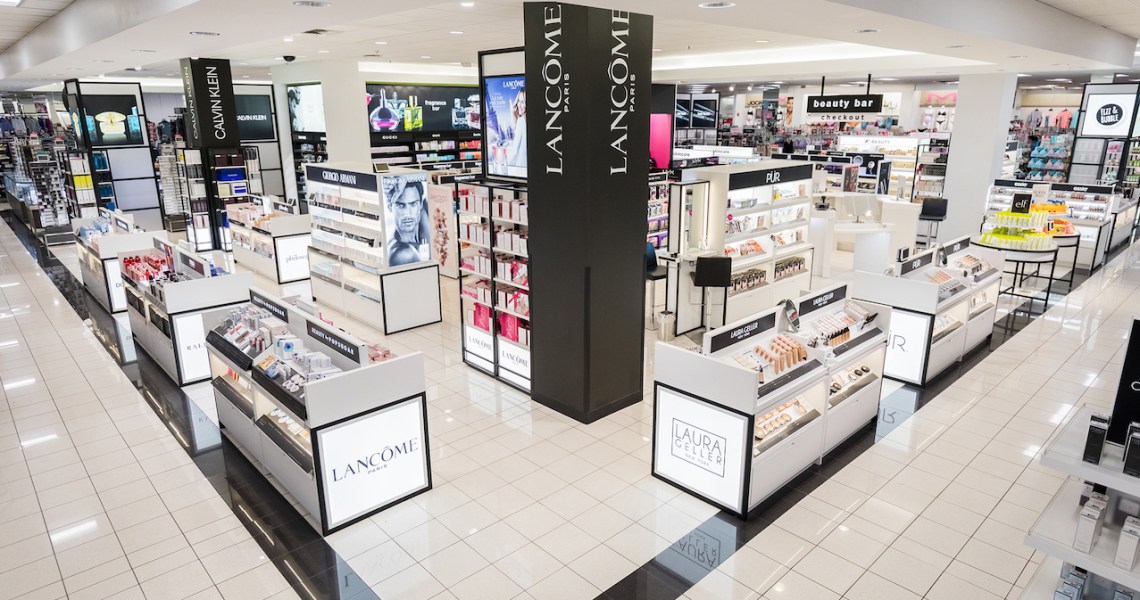This week, Kohl’s launched a concept beauty department in 12 of its stores.
Within this offering, the retailer doubled the size of the department from 750 square feet to 1,500 square feet, introduced augmented reality try-on mirrors through Modiface, created updated in-store fixtures and lighting, folded in new brands and programs like Beauty Checkout, and dedicated store associates to the space. Beauty currently accounts for less than 2% of Kohl’s sales, while the category is approximately 15% of the sales of competitors including Walmart and Target, said Doug Howe, Kohl’s chief merchandising officer. Kohl’s completed adding beauty departments in all its stores in 2016.
“Beauty is a space we’re heavily invested in, and we’re going to get pretty assertive with how aggressive we roll that out,” said Howe. “If you just look at the individual categories of business, it’s the one that single-handedly owes us the most amount of business [considering its popularity elsewhere] and provides the most upside for growth.”
All the new brands are meant to fall into “highly relevant and emerging” categories, including trends like CBD and clean beauty. Brand partners include Chopstick Hair Tools, Elizabeth and James fragrance, Jason Wu fragrance and Formawell Beauty tools by Kendall Jenner. Howe described the merchandising concept Beauty Checkout, which launched in October, as an “enabler” of the new department layout because it will sit within it. Kohl’s is evaluating the performance of the concept department and brand partners within based on factors like customer feedback, sales performance and consumer perception around the updates, such as fixtures.
“How do we become a platform to provide physical distribution for some of these emerging brands?” said Howe. “The customer will vote [with their wallet], and we’ll basically iterate based on that. These brands could come in and move out, or we could bring them into the core assortment.”
Kohl’s is not the only mass retailer experimenting with an elevated beauty aisle. In 2017, Target started updating its beauty department in 75 stores and revamped 350 more in 2018, according to The Chicago Tribune. Walmart also completed a revamp of its beauty aisle in January, while CVS is expanding its recently piloted department layout to an additional 50 doors.
“It is useful for mass retailers focusing on beauty to elevate their retail stores and encourage customers to shop in-store,” said Heather Ibberson, Edited retail analyst. “The popularity of beauty influencers has created more savvy customers who find new beauty brands on social media that they want easier accessibility to. Mass retailers can no longer afford to ignore the demand from consumers who want to test cult products in-store, especially after their favorite influencers are seen using it.”
Ad position: web_incontent_pos1
Howe said that while Kohl’s does not focus on specific customer demographics when approaching the beauty aisle, beauty does tend to over-index with younger consumers. Kohl’s shopper, on average, is between the ages of 35 and 44 — younger than Walmart, but older than Target — according to Kantar Retail’s ShopperScape. Howe sees the beauty department as helping the retailer understand the relationship that beauty has with other Kohl’s divisions, such as home and baby, in that it can monitor what else beauty customers are buying. Kohl’s can take that information and use it to increase overall basket size, similar to its approach with the launch of Kohl’s Outfit Bar in May, which provides customers with full outfit styles in-store and online.
“We’re looking at beauty now with not just the results of the individual category, but how that category is evaluated as it relates to others in the business,” said Howe. “What are the other things they have in their basket? We feel like we have this unique opportunity because we offer so much product, so how do you round out that entire experience for a customer?”




